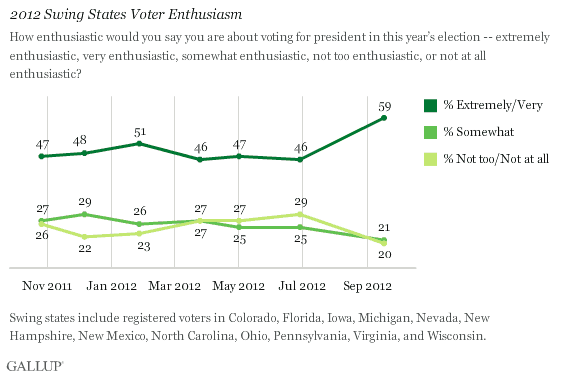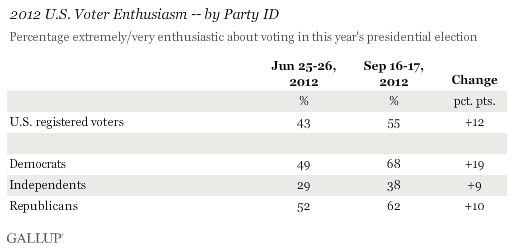PRINCETON, NJ -- Voters in the 12 states USA Today and Gallup consider the key swing states that could decide the 2012 presidential election are now significantly more enthusiastic about voting this fall than they were in June. Six in 10 (59%) are either "extremely" or "very" enthusiastic, up from 46%.

Voter enthusiasm in these states has grown among members of both political parties; however, Democrats' level has increased more. Thus, whereas equal percentages of Democrats and Republicans were enthusiastic in June, Democrats are now significantly more enthusiastic than Republicans, 73% vs. 64%.
Independents' enthusiasm also jumped substantially over this period -- up 18 points, similar to the 20-point gain among Democrats; however, independents' enthusiasm still lags behind that of both partisan groups.

Gallup finds a similar pattern among voters nationwide. Overall, 55% of U.S. registered voters in the latest poll are either extremely or very enthusiastic about voting in this fall's election, up from 43% in June. This includes a 19-percentage-point increase among Democrats and roughly 10-point increases among independents and Republicans.

The national results are based on interviews with 954 registered voters, aged 18 and older, conducted as part of Gallup Daily tracking from Sept. 16-17. The swing-state results are based on Gallup Daily tracking from Sept. 11-17, and include interviews with 1,096 registered voters in Colorado, Florida, Iowa, Michigan, Nevada, New Hampshire, New Mexico, North Carolina, Ohio, Pennsylvania, Virginia, and Wisconsin.
Implications
The rise in Democratic enthusiasm among swing-state voters is notable from the perspective that the party's supporters are more energized after that party's convention than before it, and that Democratic enthusiasm for voting now exceeds that of Republicans.
This may simply signal that Democrats are just now getting engaged in the 2012 campaign after a year when much of the focus had been on the Republicans' extended search for a presidential nominee. The Democratic convention was arguably the first major campaign event of particular interest to Democrats, whereas Republicans had a series of candidate debates and state primaries and caucuses to focus on, stretching more than six months.
Democratic gains in enthusiasm may also be a reflection of the relative impact of the two recent political conventions. Gallup's post-convention polling suggests that the Democratic convention was more successful than the Republican convention, given the post-convention bounce for Obama -- and the absence of one for Mitt Romney -- in addition to the slightly more positive evaluation of the Democratic convention than of the Republican convention. Of course, a key for the Democrats will be sustaining these enthusiasm gains in the coming weeks, as memories of the convention fade and new events -- such as the debates -- become the focus.
As more time has passed since the conventions, Obama's advantage in voting preferences with Romney among registered voters has narrowed. That makes voter turnout a more crucial factor in determining the election outcome. A continued Democratic edge in enthusiasm, especially among those in swing states, could certainly help minimize the typical Republican turnout advantages.
Track every angle of the presidential race on Gallup.com's Election 2012 page.
Survey Methods
Results for voters in 2012 election swing states are based on telephone interviews conducted Sept. 11-17, 2012, on the Gallup Daily tracking survey, with a random sample of 1,096 registered voters, aged 18 and older, living in Colorado, Florida, Iowa, Michigan, Nevada, New Hampshire, New Mexico, North Carolina, Ohio, Pennsylvania, Virginia, and Wisconsin. The data represent a subset of Gallup's national daily tracking survey for those dates. The swing-state data are weighted to be demographically representative of the combined population in those 12 states.
For results based on the total sample of swing-state registered voters, one can say with 95% confidence that the maximum margin of sampling error is ±4 percentage points.
Interviews are conducted with respondents on landline telephones and cellular phones, with interviews conducted in Spanish for respondents who are primarily Spanish-speaking. Each sample includes a minimum quota of 400 cell phone respondents and 600 landline respondents per 1,000 national adults, with additional minimum quotas among landline respondents by region. Landline telephone numbers are chosen at random among listed telephone numbers. Cell phone numbers are selected using random-digit-dial methods. Landline respondents are chosen at random within each household on the basis of which member had the most recent birthday.
Samples are weighted by gender, age, race, Hispanic ethnicity, education, region, adults in the household, and phone status (cell phone only/landline only/both, cell phone mostly, and having an unlisted landline number). Demographic weighting targets are based on the March 2011 Current Population Survey figures for the aged 18 and older non-institutionalized population living in U.S. telephone households. All reported margins of sampling error include the computed design effects for weighting and sample design.
In addition to sampling error, question wording and practical difficulties in conducting surveys can introduce error or bias into the findings of public opinion polls.
View methodology, full question results, and trend data.
For more details on Gallup's polling methodology, visit www.gallup.com.
